Voting Guide 2020: Issues That Matter to Seniors
This guide tackles some of the most important issues facing older Americans ahead of the 2020 election — including how to safely vote during a pandemic. We’ll explore what’s at stake for Medicare, Social Security, the future of prescription drug prices, and more.
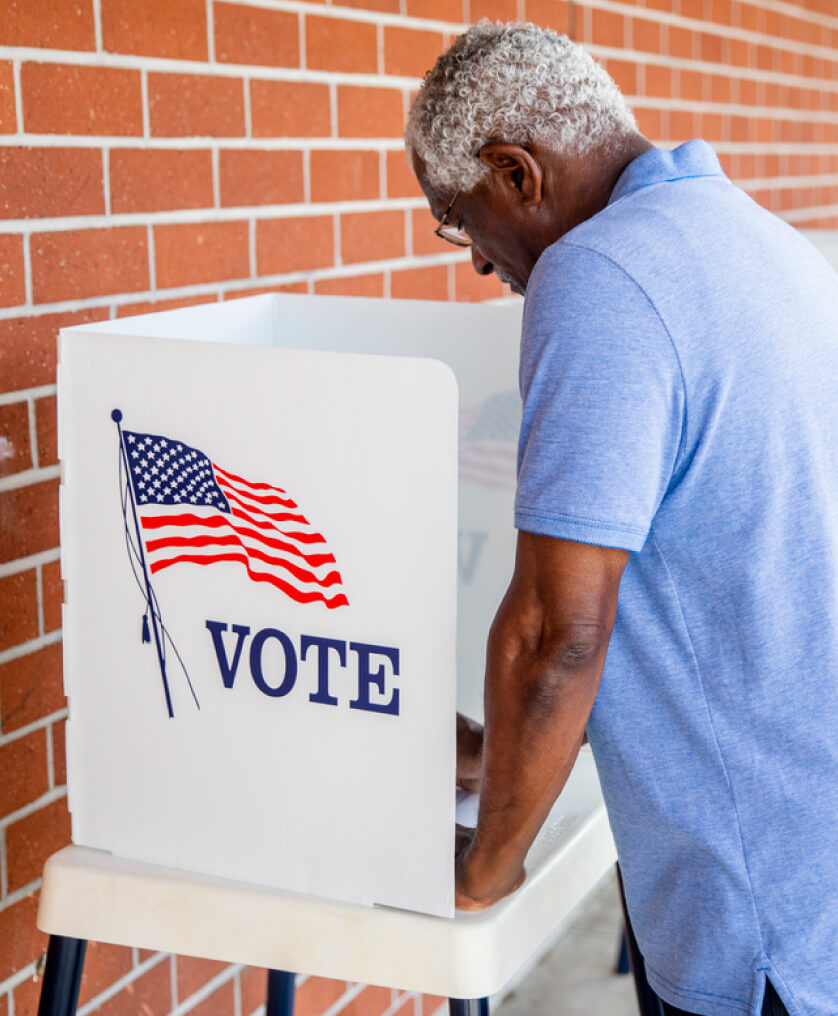
- Written by Rachel Christian
Rachel Christian
Financial Writer and Certified Educator in Personal Finance
Rachel Christian is a writer and researcher for RetireGuide. She covers annuities, Medicare, life insurance and other important retirement topics. Rachel is a member of the Association for Financial Counseling & Planning Education.
Read More- Edited By
Matt Mauney
Matt Mauney
Financial Editor
Matt Mauney is an award-winning journalist, editor, writer and content strategist with more than 15 years of professional experience working for nationally recognized newspapers and digital brands. He has contributed content for ChicagoTribune.com, LATimes.com, The Hill and the American Cancer Society, and he was part of the Orlando Sentinel digital staff that was named a Pulitzer Prize finalist in 2017.
Read More- Published: July 22, 2020
- Updated: October 13, 2023
- 20 min read time
- This page features 61 Cited Research Articles
- Edited By
Older Americans are widely considered the backbone of American elections.
According to U.S. Census Bureau data, nearly 71 percent of voters age 65 and older cast a ballot in the 2016 presidential election, compared to just 46 percent of younger voters age 18 to 29.
When the number of voting-eligible citizens increased by nearly 9 million people between 2012 and 2016, almost 6 million of them — about two-thirds — were over 65.
In short: Seniors turn out to vote.
Experts say this leads many candidates to focus on key issues such as Medicare, prescription drug prices and Social Security benefits during election years.
“If past predicts the future, older voters will continue to play an outsized role in the coming election,” Tricia Neuman, executive director of the Kaiser Family Foundation’s Program on Medicare Policy, told RetireGuide.

Voting Trends of Older Americans
Older Americans are anticipated to play a crucial role in the 2020 general election.
Pew Research found baby boomers are almost evenly divided among the two main political parties, with 48 percent identifying as Republican and 46 percent identifying as Democrat.
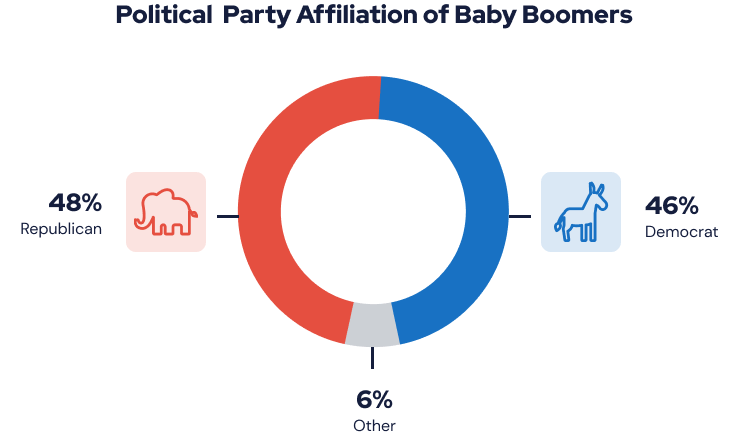
In 2018, men ages 65 and older were slightly more likely to cast a ballot than women in the same age group, according to the U.S. Census Bureau.
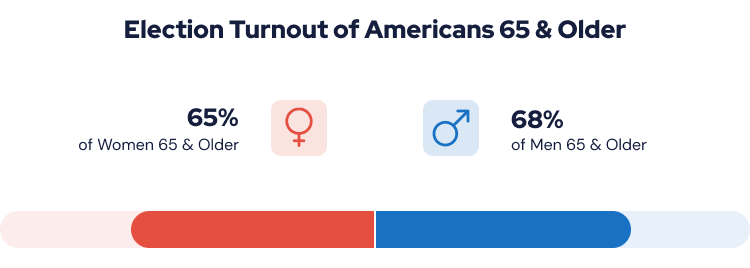
But a survey by AARP and Harris Poll suggests that female voters over age 50 may hold the key to this year’s election.
According to the poll, 95 percent of older female voters say they plan to cast a ballot in November. Only 1 percent said they don’t plan to vote.
Health care emerged as the top issue for female voters in the survey. It found that nearly seven in 10 women over age 50 believe older people pay too much for health care compared to others.
Location also plays a role in voter turnout.
For example, 79 percent of Maine and Minnesota voters age 65 and older cast a ballot in 2018, compared to 56 percent of older voters in Hawaii, according to the U.S. Census Bureau.
Why Do Older Americans Vote?
Experts cite several reasons why older Americans consistently turnout to the polls more than their younger counterparts.
- Vested Interest in Social Programs
- Millions of retirees depend on government programs such as Medicare and Social Security. Research indicates that voting for candidates who protect these benefits motivates and mobilizes many seniors to vote.
- Community Investment
- Young people tend to move around more frequently than older people, which makes them less likely to be registered to vote. Because older voters often live in the same community longer, they may be more informed about state and local issues. More seniors also tend to be property owners and have greater interaction with government services.
- More Experience
- Older people have often voted many times before, and are generally more familiar with registration deadlines, polling locations and how to cast a ballot than younger voters.
- More Time to Vote
- A 2018 survey from Tufts University found roughly 45 percent of younger people said they were too busy to vote or had a conflict on Election Day. Retirees don't face the same time crunch, which gives them a greater opportunity to make campaign donations, write letters, attend meetings and vote.
Not Just the Presidency at Stake
The presidency is just one of many elections on the ballot this year.
All 435 seats in the U.S. House of Representatives are up for grabs, including 36 seats in which the incumbent isn’t seeking reelection. Currently, 233 House seats are held by Democrats and 197 by Republicans.
On the Senate side, 35 seats are in play for 2020, of which 23 are currently held by Republicans.
Eleven states are also picking governors this year, along with thousands of state legislature and local government positions across the country.
Medicare Reform and Expansion
Medicare is considered one of the country’s most successful social programs.
It’s undergone a series of reforms and expansions since launching in 1965. Medicare now serves roughly 60 million Americans — about 18 percent of the U.S. population.
Experts estimate Medicare enrollment to include more than 80 million people by 2030.
Meanwhile, “Medicare for All” is an increasingly popular talking point in modern politics.
The proposal — advanced by progressive politicians such as Vermont Sen. Bernie Sanders — aims to create a universal health care program that eliminates private insurance plans.
Over half, or about 52 percent, of the public says it now favors a Medicare for All plan in which all Americans would get their insurance from a single government plan, according to 2020 research from the Kaiser Family Foundation.
However, Medicare for All proposals typically include better coverage and access than actual Medicare.
Over the last two decades, Medicare has become more privatized.
Original Medicare (Part A and Part B) is run by the federal government. It remains the most popular option, covering about two-thirds of all Medicare beneficiaries.
Meanwhile, Medicare Advantage (Part C) plans are administered by private insurance companies that Medicare reimburses.
Stand-alone Medicare Part D prescription drug plans and Medigap supplemental insurance policies are also administered by private companies.
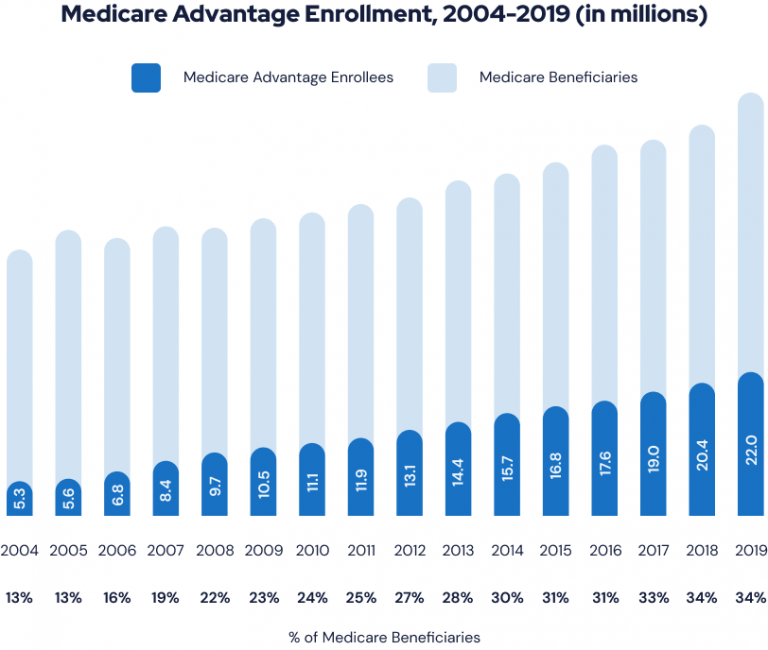
Researchers found that Medicare plan payment policies have shifted over time, from policies that created savings to ones that focus more on expanding access to private plans and including more benefits to people enrolled in private Medicare plans.
Experts say efforts to widen Medicare privatization are likely to continue, even as calls for Medicare expansion increase.
Proposed Cuts and Spending Reductions
As baby boomers continue to age into Medicare, program costs are expected to rise.
Medicare spending is projected to grow an average of 7.6 percent each year between 2020 and 2027.
In 2018, Medicare benefit payments totaled $731 billion, up from $462 billion a decade earlier.
Meanwhile, President Donald Trump’s proposed 2021 budget outlines $500 to $755 billion in reduced Medicare spending over the next decade.
Most of these proposed cuts would come from lowering payments to health care providers — not benefits to people enrolled in Medicare.
For example, under Trump’s proposal, all doctors would be paid the same price for services, whether they work for a hospital or a private practice.
Other recommendations in Trump’s 2021 budget include allowing people to opt out of Medicare Part A hospital coverage without it interfering with their Social Security benefits.
A president’s proposed budget is more wish list than mandate. Any changes to Medicare would need to make it through Congress first.
After Trump’s first proposed budget in 2017, the Pew Research Center found 85 percent of surveyed Republicans and 94 percent of Democrats wanted to maintain or increase Medicare spending.
Health care reforms proposed by Democratic presidential candidate Joe Biden aim to build on the Affordable Care Act.
Biden also strongly supported repealing a law that prevents Medicare from negotiating lower prescription drug prices with pharmaceutical companies.
The former vice president said he doesn’t plan to cut money from Medicare or Social Security if he’s elected.
“There will be no compromise on cutting Medicare and Social Security, period. That’s a promise,” Biden said Jan. 20, 2020 at the 2020 Iowa Brown & Black Presidential Forum.
Impact of a Repeal of the Affordable Care Act
In March 2020, the Supreme Court decided to take a case that will decide whether the Affordable Care Act (ACA) remains in effect.
Trump — along with many Republicans — has long opposed the sweeping health care expansion implemented under former President Barack Obama’s administration in 2010.
Striking down most or all of the ACA would have far-reaching impacts on the country’s health care system.
- Eliminate coverage of free preventive care services.
- Discard a provision that prohibits Medicare Advantage plans from charging higher prices on chemotherapy, dialysis, skilled nursing care and other services.
- Reopen the costly Medicare Part D prescription drug coverage gap, known as the “donut hole.”
From 2010 to 2017, nearly 12 million Medicare beneficiaries saved $26.8 billion on prescription drugs, according to the U.S. Department of Health and Human Services.
The savings are due in large part to an ACA provision that gradually closed a major coverage gap, known as the donut hole.
Previously, Part D beneficiaries had to pay the full cost of prescription drugs after hitting an initial coverage limit.
“Some of those drugs, especially for cancer care, are extremely expensive,” Mary Johnson, a Social Security and Medicare policy analyst for The Senior Citizens League, a nonpartisan advocacy group, told RetireGuide. “Those drugs can run into thousands of dollars for just a few refills.”
This forced thousands of seniors to pay high prices until they hit a second threshold and coverage returned.
“When drugs are not priced at a level people can afford, that is a life-threatening situation.”
The ACA gradually phased out the donut hole gap between 2011 and 2020.
Now, beneficiaries pay 75 percent less for brand-name and generic drugs within the coverage gap than before the ACA went into effect.
Johnson told RetireGuide that repealing the ACA could force thousands of seniors to make tough choices between health and money.
“When drugs are not priced at a level people can afford, that is a life-threatening situation,” Johnson said. “It would cause people with modest retirement incomes to make some horrible decisions.”
Experts say the Supreme Court is unlikely to make a final ruling on the ACA prior to the election.
The ACA remains in effect while the litigation is pending.
Lowering the Medicare Eligibility Age
In April 2020, Biden proposed dropping the Medicare eligibility age from 65 to 60 years old.
Up to 20 million more Americans could be eligible for Medicare under his plan.
Biden said in a post on Medium that his call to lower the age that people can sign up for Medicare is a direct response to the COVID-19 pandemic.
Details are lean, but Biden said people age 60 to 64 could choose to remain on their employer’s health insurance if they like it, or they could opt-in to Medicare.
It’s a more progressive departure from his position last year.
Previously, Biden supported the idea of people age 60 to 64 enrolling in a parallel, Medicare-like plan run by the federal government.
His new proposal simply drops the Medicare eligibility age from 65 to 60.
Experts say it’s less complicated to implement but more controversial.
In recent years, Republicans have actually pushed to raise the eligibility age — not lower it.
There’s also some concern about how the government could finance such a large influx of new Medicare enrollees.
But Johnson argues that there’s plenty of ways to pay for lowering the Medicare eligibility age.
“It’s all in the way members of Congress design programs,” Johnson said. “At the end of the day, this is our program. We have a say in how we want it to work.”
Recent research shows widespread public support for expanding Medicare.
A 2020 survey by the Kaiser Family Foundation found that 77 percent of Americans support the idea of allowing people ages 50 to 64 to buy insurance through Medicare.
Addressing Long-Term Care
It’s estimated that 70 percent of people age 65 and older will need some form of long-term care during their lifetime.
But long-term care is expensive.
The cost of a private room in a nursing home totaled more than $100,000 a year in 2018, according to AARP.
Medicare does not pay for extended stays at nursing homes or assisted living facilities. This forces many families to rely on Medicaid, which kicks in once seniors have depleted most of their assets.
In 2018, federal and state Medicaid spending totaled $597.4 billion — and more than 20 percent of that went to long-term care services.
All the major Democratic presidential hopefuls — including Biden — discussed plans to assist people who receive long-term supports.
But candidates differed on how to solve the problem.
Biden’s main initiative is a $5,000 non-refundable tax break for family caregivers who make less than $75,000 a year.
He’s also proposed increased federal funding for caregiver respite services such as adult day care.
In May, the U.S. Department of Health and Human Services announced plans to distribute about $4.9 billion in additional relief to help skilled nursing facilities combat the coronavirus.
According to a news release, eligible facilities will receive a fixed distribution of $50,000, plus $2,500 per bed.
As of July 2020, at least 59,000 residents and workers at nursing homes and other long-term care facilities had died from COVID-19, according to The New York Times. More than 335,000 people had been infected with the virus at 15,000 facilities.
Prescription Drug Prices
Nearly 80 percent of older Americans believe the cost of prescription drugs is unreasonable, according to 2019 research by the Kaiser Family Foundation.
Even with Medicare Part D coverage, some seniors face major out-of-pocket expenses for medications — especially if they take specialty drugs or multiple high-cost brand-name drugs.
Over the last year, Congress has considered multiple proposals to drop consumer drug costs.
The Senate Finance Committee approved a bipartisan bill called the Prescription Drug Pricing Reduction Act in July 2019.
By December 2019, a different bill passed the House — the Elijah E. Cummings Lower Drug Costs Now Act.
- Price transparency for medical services
- Redesign of Part D coverage
- Monthly out-of-pocket cap on expenses
- Establishment of standard pharmacy quality measures
- Drug manufacturer price transparency
- Reporting of excessive price hikes
Trump has also advocated for lowering prescription drug costs.
On July 24, Trump announced four new executive orders aimed at reducing prescription drug prices for consumers.
Proposals include importing drugs from other counties, directing drug maker rebates straight to patients, linking the price seniors pay for certain physician-administered medicines to prices paid in foreign countries, and passing insulin savings on to patients who receive the drug from certain low-income community health centers.
It may take months for the Trump administration to finalize the orders.
The new rules have already received pushback from drug makers and may face court battles. It is unclear if any changes will impact consumers before November.
“With each passing day, it seems less likely that lawmakers will come to an agreement on major changes to lower drug prices before the election,” Neuman said. “But it is possible.”
Ask an Expert: Drug Costs and Medicare

Tricia Neuman is the senior vice president of the Henry J. Kaiser Family Foundation, a nonprofit, nonpartisan group focused on health policy issues. She also serves as executive director of the KFF’s Program on Medicare Policy, where she oversees analysis and research related to Medicare.
Neuman has authored many peer-reviewed research papers on Medicare and has been invited several times to present expert testimony before congressional committees.
- Why have efforts to lower prescription drug prices stalled in the House and Senate?
The bill that passed the House of Representatives [the Elijah E. Cummings Lower Drug Costs Now Act] would have a significant impact on drug prices and spending, according to the Congressional Budget Office — which probably explains why it has encountered strong resistance from the drug industry.
The House bill includes a number of policy changes to lower drug prices, including a signature proposal to allow the secretary to negotiate lower drug prices for people on Medicare and private insurance.
Last year, the Senate Finance Committee adopted a prescription drug proposal — but without strong bipartisan support. It is not clear whether a version of the so-called Grassley/Wyden compromise will be brought to the Senate floor before the end of this congressional session.
- Are any other measures likely to impact drug prices before the 2020 election?
The Trump administration has adopted a new model to help Medicare beneficiaries with the cost of insulin, which will take effect in 2021.
As for broader reforms that would have a big impact on drug pricing, the clock is ticking.
- Why is it important for candidates to address the issue of drug costs and Medicare?
Drug prices are a pocketbook issue for seniors and other consumers who know exactly what they pay each time they fill their prescriptions.
Republicans, Democrats and independents may not see eye to eye on many issues but agree that government should do something about drug prices.
- How important will it be for both presidential candidates to capture the 50 and older voter bloc this election?
Candidates are well aware that a larger share of older than younger adults go to the polls. This is why we often hear candidates talk about protecting Medicare and Social Security prior to an election.
These programs matter to older voters because they depend on them for their economic security in retirement.
Future of Social Security
Social Security is a vital source of income for millions of older Americans.
In 2019, nearly nine out of 10 retired workers — about 45 million people — received benefits through the program.
But Social Security has been on shaky financial footing for decades.
According to the Social Security Board of Trustees’ 2020 annual report, trust funds that deliver will be depleted by 2035.
If that happens, benefit cuts of up to 24 percent may be necessary to keep retiree payments going.
The coronavirus pandemic and resulting high unemployment rates may further complicate Social Security’s fiscal future.
That’s because millions of workers and their employers haven’t consistently contributed payroll taxes — Social Security’s primary funding source.
Trump’s proposed 2021 budget includes cuts to the Social Security program.
However, reductions focus on the part of Social Security that provides benefits to about 8.5 million disabled workers — not monthly retirement benefits.
Biden’s platform describes protections for Social Security and promises to strengthen benefits for its most vulnerable recipients.
He’s called for raising Social Security payroll taxes on wealthier Americans to help keep the program solvent.
Another Biden proposal would increase benefits for older seniors who have received Social Security checks for at least 20 years.
He’s also campaigned to increase Social Security benefits for widows and widowers.
Taxes, Financial Security and Retirement
Older Americans enjoy the benefit of age-related tax breaks and credits.
If you or your spouse are 65 or older and you meet certain income requirements, you may be eligible to claim a tax credit for the elderly.
In 2020, the tax credit ranged from $3,750 to $7,500, depending on your income and filing status.
You can use this IRS online tool to see if you qualify for the credit.
Older Americans also get a bigger standard deduction at tax time and can earn higher annual incomes before they must file a tax return at all.
Some states may also offer property tax deferrals or exemptions for low-income seniors.
Tax breaks for seniors cost states approximately $27 billion each year — and that could double in the next decade, according to the Center on Budget and Policy Priorities.
On the federal level, 46 percent of surveyed senior households paid taxes on a portion of their Social Security benefits in 2018, according to an analysis by the Senior Citizens League.
During the Democratic debates, Biden outlined several additional tax breaks for seniors.
His plan details increased tax benefits for older Americans who use their retirement savings to pay for long-term care insurance.
Biden also said he will allow low-wage workers ages 65 and older to claim the earned income tax credit. Currently, IRS tax code prohibits this.
Not much is known about Trump’s second-term tax proposal.
In late 2017, Trump signed the Tax Cuts and Jobs Act into law. It’s considered one of the most sweeping reforms of U.S. tax code in 30 years.
Major provisions included lowering the peak marginal corporate income tax rate from 35 percent to 21 percent and providing income tax breaks for individuals.
Measures within the Tax Cuts and Jobs Act are set to expire at the end of 2025.
Voting Options for Seniors
As U.S. COVID-19 cases climb, in-person voting is causing concern among many Americans — especially seniors.
According to the Centers for Disease Control and Prevention, eight out of 10 COVID-19-related deaths in the U.S. have involved adults 65 and older.
CDC guidance released June 22 cautioned, “Elections with only in-person voting on a single day are higher risk for COVID-19 spread because there will be larger crowds and longer wait times.”
Election officials are battling another obstacle this year: Finding enough poll workers to staff in-person voting locations.
About 58 percent of U.S. poll workers in the 2018 general election were over 60 years old, according to the Pew Research Center.
With more elderly poll workers opting to stay home this year, the number of in-person voting locations may decrease.
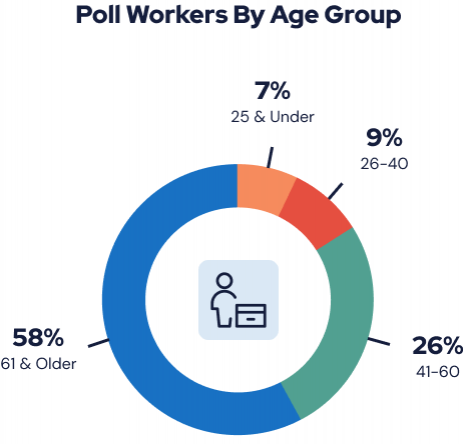
Many states are also eliminating nursing homes and assisted living facilities as polling spots.
Meanwhile, vote-by-mail is becoming increasingly attractive to many voters.
An April poll conducted by the Pew Research Center found that 70 percent of Americans favor allowing any voter to vote by mail if they want to.
- Vote by Mail
- States have worked to expand vote-by-mail access in the wake of the coronavirus pandemic. Now, 46 of 50 states and the District of Columbia offer some form of vote-by-mail for all voters. Four states still require absentee voters to provide an “excuse,” such as serving overseas in the military. For specific information on your state’s vote-by-mail rules and deadlines, visit Vote.org’s Absentee Ballot Deadlines.
- Early Voting
- State rules vary widely on how long in-person early voting lasts and when it begins. A handful of states do not offer in-person early voting at all. For a state-by-state overview of early voting dates, visit Vote.org.
- Election Day
- The General Election takes place Nov. 3, 2020.
Additional Resources for Senior Voters
- Rock the Vote COVID-19 Voting Information
- Rock the Vote is a nonpartisan group focused on expanding voter access. Its website features a helpful state-by-state guide on election changes due to the COVID-19 pandemic along with information on vote-by-mail. You can also sign up for their election reminders to receive updates via email about elections in your area.
- Vote 411
- This website from the League of Women Voters serves as a one-stop-shop for personalized election information. Enter your mailing address, and Vote 411 lets you check your voter registration, see what’s on your ballot, explore upcoming debates in your area, and more.
- ACLU’s Guide on Voter Rights
- The American Civil Liberties Union offers a helpful page about how to exercise your voting rights, resist voter intimidation and access disability-related accommodations and language assistance at the polls.
61 Cited Research Articles
- U.S. Department of Health & Human Services. (2020, July 24). Trump Administration Announces Historic Action to Lower Drug Prices for Americans. Retrieved from https://www.vbb.com/media/Insights_Articles/Trump_Administration_Announces_Historic_Action_to_Lower_Drug_Prices_for_Americans___HHS.gov.pdf
- The New York Times. (2020, July 7). More Than 40% of U.S. Coronavirus Deaths Are Linked to Nursing Homes. Retrieved from https://www.nytimes.com/interactive/2020/us/coronavirus-nursing-homes.html
- Laise, E. (2020, July 2). Trump plan to kill Affordable Care Act threatens coronavirus-ravaged nursing homes. Retrieved from https://www.marketwatch.com/story/trump-plan-to-kill-aca-threatens-struggling-nursing-homes-2020-07-01
- Centers for Disease Control and Prevention. (2020, June 22). Considerations for Election Polling Locations and Voters. Retrieved from https://www.cdc.gov/coronavirus/2019-ncov/community/election-polling-locations.html
- Parks, M. (2020, June 4). Why Is Voting By Mail (Suddenly) Controversial? Here's What You Need To Know. Retrieved from https://www.npr.org/2020/06/04/864899178/why-is-voting-by-mail-suddenly-controversial-heres-what-you-need-to-know
- Dzhanova, Y. (2020, June 1). Some voters are scared the coronavirus will stop them from casting a ballot. Retrieved from https://www.cnbc.com/2020/06/01/some-voters-are-scared-coronavirus-will-stop-them-from-casting-ballot.html
- Kaiser Family Foundation. (2020, May 27). Public Opinion on Single-Payer, National Health Plans, and Expanding Access to Medicare Coverage. Retrieved from https://www.kff.org/slideshow/public-opinion-on-single-payer-national-health-plans-and-expanding-access-to-medicare-coverage/
- Perez, E. (2020, May 27). The Bipartisan Truth About By-Mail Voting. Retrieved from https://trustthevote.org/wp-content/uploads/2020/05/27May20_BipartisanTruthAboutByMailVoting_v3.pdf
- Alonso-Zaldivar, R. (2020, May 26). Trump announces deal to reduce insulin prices for seniors. Retrieved from https://www.pbs.org/newshour/politics/watch-live-trump-delivers-remarks-in-on-protecting-seniors-with-diabetes
- Centers for Medicare & Medicaid Services. (2020, May 26). President Trump Announces Lower Out of Pocket Insulin Costs for Medicare’s Seniors. Retrieved from https://www.cms.gov/newsroom/press-releases/president-trump-announces-lower-out-pocket-insulin-costs-medicares-seniors
- U.S. Health and Human Services. (2020, May 22). HHS Announces Nearly $4.9 Billion Distribution to Nursing Facilities Impacted by COVID-19. Retrieved from https://web.archive.org/web/20210617174305/https://www.hhs.gov/about/news/2020/05/22/hhs-announces-nearly-4.9-billion-distribution-to-nursing-facilities-impacted-by-covid19.html
- Levine, C. (2020, May 13). Elderly poll workers run U.S. elections. But COVID-19 will keep legions home. Retrieved from https://www.nbcnews.com/politics/2020-election/elderly-poll-workers-run-u-s-elections-covid-19-will-n1205761
- Garrison, J. (2020, May 4). USA TODAY/Suffolk Poll: Americans overwhelmingly support vote-by-mail push, but Republicans more wary. Retrieved from https://www.usatoday.com/story/news/politics/2020/05/04/coronavirus-americans-overwhelmingly-support-vote-mail-push/3063765001/
- Bunis, D. (2020, April 23). What Will Happen to Medicaid After the Election? Retrieved from https://www.aarp.org/politics-society/government-elections/info-2020/issues-for-2020-election-medicaid.html?intcmp=DC-POL-ELC-R1C2
- Japsen, B. (2020, April 12). Biden’s ‘Medicare At 60’ Targets Early Retirees And The Unemployed. Retrieved from https://www.forbes.com/sites/brucejapsen/2020/04/12/bidens-medicare-at-60-targets-early-retirees-and-the-unemployed/#5adae47b41d0
- Rovner, J. (2020, April 11). Biden's Health Play In A COVID-19 Economy: Lower Medicare's Eligibility Age To 60. Retrieved from https://www.npr.org/sections/health-shots/2020/04/11/832025550/bidens-health-play-in-a-covid-19-economy-lower-medicares-eligibility-age-to-60
- Barthel, M. and Stocking, G. (2020, April 6). Older people account for large shares of poll workers and voters in U.S. general elections. Retrieved from https://www.pewresearch.org/fact-tank/2020/04/06/older-people-account-for-large-shares-of-poll-workers-and-voters-in-u-s-general-elections/
- Waggoner, J. (2020, March 27). Do You Qualify for a Tax Credit for the Elderly or Disabled? Retrieved from https://www.aarp.org/money/taxes/info-2020/tax-credits-eligibility.html
- Centers for Medicare & Medicaid Services. (2020, Match 24). NHE Fact Sheet. Retrieved from https://www.cms.gov/Research-Statistics-Data-and-Systems/Statistics-Trends-and-Reports/NationalHealthExpendData/NHE-Fact-Sheet
- Perrett, C. (2020, March 11). Senior citizens have the highest rates of voter turnout but coronavirus could change the game and keep older voters home. Retrieved from https://www.businessinsider.com/senior-voter-turnout-at-risk-over-coronavirus-worries-2020-3
- Musumeci, M. (2020, March 10). Explaining Texas v. U.S.: A Guide to the Case Challenging the ACA. Retrieved from https://www.kff.org/health-reform/issue-brief/explaining-california-v-texas-a-guide-to-the-case-challenging-the-aca/
- Kessler, G. (2020, March 8). Sanders vs. Biden on Social Security: A guide to the claims. Retrieved from https://www.washingtonpost.com/politics/2020/03/08/sanders-versus-biden-social-security-guide-claims/
- Internal Revenue Service. (2020, February 25). Publications for Older Americans. Retrieved from https://www.irs.gov/individuals/seniors-retirees/publications-for-older-americans
- Kirzinger, A., Kearney, A. and Brodie, M. (2020, February 21). KFF Health Tracking Poll – February 2020: Health Care in the 2020 Election. Retrieved from https://www.kff.org/health-reform/poll-finding/kff-health-tracking-poll-february-2020/
- Van de Water, P. N. (2020, February 13). Medicare in the 2021 Trump Budget. Retrieved from https://www.cbpp.org/blog/medicare-in-the-2021-trump-budget
- Malito, A. (2020, February 12). Trump’s budget proposal probably won’t reduce your Social Security check, experts say, but will it lower your quality of life and health care? Retrieved from https://www.marketwatch.com/story/trumps-budget-proposal-wont-reduce-your-social-security-check-but-it-could-lower-your-quality-of-life-and-health-care-2020-02-11
- O’Brian, S. (2020, February 12). Two items buried in Trump’s budget call for big changes to Medicare. Retrieved from https://www.cnbc.com/2020/02/12/two-items-buried-in-trumps-budget-call-for-big-changes-to-medicare.html
- Picchi, A. (2020, February 12). Social Security: Here’s what Trump’s proposed budget could mean for your benefits. Retrieved from https://www.usatoday.com/story/money/2020/02/12/social-security-trump-budget-aims-cuts-disabled-workers-program/4738795002/
- Mercado, D. (2020, February 10). Trump wants to extend his tax overhaul. What it means for you. Retrieved from https://www.cnbc.com/2020/02/10/trump-wants-to-extend-his-tax-overhaul-what-it-means-for-you.html
- Sanger-Katz, M. (2020, February 10). What’s in President Trump’s Fiscal 2021 Budget? Retrieved from https://www.nytimes.com/2020/02/10/business/economy/trump-budget-explained-facts.html
- Farley, R. (2020, January 24). Biden vs. Sanders on Social Security and Medicare. Retrieved from https://www.factcheck.org/2020/01/biden-vs-sanders-on-social-security-and-medicare/
- Gleckman, G. (2020, January 21). How The Democratic Presidential Candidates Would Address Long-Term Care. Retrieved from https://www.forbes.com/sites/howardgleckman/2020/01/21/how-the-democratic-presidential-candidates-would-address-long-term-care/#2791e85e6e9c
- Povich, E. (2020, January 17). Seniors’ Sweet Tax Breaks Have Become a Target. Retrieved from https://www.pewtrusts.org/en/research-and-analysis/blogs/stateline/2020/01/17/seniors-sweet-tax-breaks-have-become-a-target
- Span, P. (2020, January 17). Medicare’s Part D Doughnut Hole Has Closed! Mostly. Sorta. Retrieved from https://www.nytimes.com/2020/01/17/health/medicare-drug-costs.html
- Wynne, B. and Llamas, A. (2020, January 9). New Legislation to Control Drug Prices: How Do House and Senate Bills Compare? An Update. Retrieved from https://www.commonwealthfund.org/blog/2020/new-legislation-control-drug-prices-how-do-house-and-senate-bills-compare-update
- Ballotpedia. (2020). United States Congress Elections, 2020. Retrieved from https://ballotpedia.org/United_States_Congress_elections,_2020#Incumbents_not_seeking_re-election_in_2020
- JoeBiden.com. (2020). The Biden Plan for Older Americans. Retrieved from https://web.archive.org/web/20230424235145/https://joebiden.com/older-americans/
- Social Security Administration. (2020). Fact Sheet. Retrieved from https://www.ssa.gov/news/press/factsheets/basicfact-alt.pdf
- Internal Revenue Service. (2019, December 20). Do I Qualify for the Credit for the Elderly or Disabled? Retrieved from https://www.irs.gov/help/ita/do-i-qualify-for-the-credit-for-the-elderly-or-disabled
- Bunis, D. (2019, December 18). Exclusive Poll: Women 50 and Older Could Decide the 2020 Election. Retrieved from https://www.aarp.org/politics-society/government-elections/info-2019/women-voting-poll.html
- Van De Water, P. (2019, November 7). Executive Order, Other Administration Actions Would Weaken Medicare. Retrieved from https://www.cbpp.org/research/health/executive-order-other-administration-actions-would-weaken-medicare
- Munro, D. (2019, October 9). Trump Executive Order Sparks Concern Over Medicare Funding. Retrieved from https://www.forbes.com/sites/danmunro/2019/10/08/trumps-executive-order-could-bankrupt-the-medicare-trust-funds-in-less-than-5-months/#40b2d00c8e2a
- Cubanski, J., Neuman, T. and Freed, M. (2019, August). The Facts on Medicare Spending and Financing. Retrieved from https://web.archive.org/web/20221113205204/https://files.kff.org/attachment/Issue-Brief-Facts-on-Medicaid-Spending-and-Financing
- Micnichol, E. (2019, June 19). States Should Target Senior Tax Breaks Only to Those Who Need Them, Free up Funds for Investments. Retrieved from https://www.cbpp.org/research/state-budget-and-tax/states-should-target-senior-tax-breaks-only-to-those-who-need-them
- Kaiser Family Foundation. (2019, June 6). Medicare Advantage. Retrieved from https://www.kff.org/medicare/issue-brief/medicare-advantage-in-2022-enrollment-update-and-key-trends/
- Internal Revenue Service. (2019). Publication 554 (2019), Tax Guide for Seniors. Retrieved from https://www.irs.gov/publications/p554
- U.S. Department of Health and Human Services. (2018, October 25). Comparison of U.S. and International Prices for Top Medicare Part B Drugs by Total Expenditures. Retrieved from https://aspe.hhs.gov/sites/default/files/private/pdf/259996/ComparisonUSInternationalPricesTopSpendingPartBDrugs.pdf
- Sackett, V. (2018, October 24). Nursing Home Costs Top $100,000 a Year. Retrieved from https://www.aarp.org/caregiving/financial-legal/long-term-care-cost-calculator/
- Ingraham, C. (2018, October 15). Where people show up to vote — and where they don’t. Retrieved from https://www.washingtonpost.com/business/2018/10/15/where-people-show-up-vote-where-they-dont/
- Center for Information & Research on Civil Learning and Engagement. (2018, August 21). Why Youth Don’t Vote: Differences by Race and Education. Retrieved from https://circle.tufts.edu/latest-research/why-youth-dont-vote-differences-race-and-education
- Bunis, D. (2018, April 30). The Immense Power of the Older Voter. Retrieved from https://www.aarp.org/politics-society/government-elections/info-2018/power-role-older-voters.html
- U.S. Elections Assistance Commission. (2017, November 15). EAVS Deep Dive: Poll Workers and Polling Places. Retrieved from https://www.eac.gov/documents/2017/11/15/eavs-deep-dive-poll-workers-and-polling-places
- U.S. Health and Human Services. (2017, October 10). Long-Term Care Basics. Retrieved from https://acl.gov/ltc/basic-needs
- Gramlich, J. (2017, May 26). Few Americans support cuts to most government programs, including Medicaid. Retrieved from https://www.pewresearch.org/fact-tank/2017/05/26/few-americans-support-cuts-to-most-government-programs-including-medicaid/
- Center for Medicare & Medicaid Services. (2017, January 13). Nearly 12 million people with Medicare have saved over $26 billion on prescription drugs since 2010. Retrieved from https://www.cms.gov/newsroom/press-releases/nearly-12-million-people-medicare-have-saved-over-26-billion-prescription-drugs-2010
- Okrent, D. (2015, June). Long-Term Services and Supports: Changes and Challenges in Financing and Delivery. Retrieved from http://www.allhealthpolicy.org/wp-content/uploads/2017/01/LTSS-Toolkit_166.pdf
- Brandon, E. (2012, March 19). Why Older Citizens are More Likely to Vote. Retrieved from https://money.usnews.com/money/retirement/articles/2012/03/19/why-older-citizens-are-more-likely-to-vote
- AARP. (n.d.). How much longer will Social Security be around? Retrieved from https://www.aarp.org/retirement/social-security/questions-answers/how-much-longer-will-social-security-be-around/
- Medicaid.gov. (n.d.). Long Term Services & Supports. Retrieved from https://www.medicaid.gov/medicaid/long-term-services-supports/index.html
- MIT Election Data Science Lab. (n.d.). Voter turnout. Retrieved from https://electionlab.mit.edu/research/voter-turnout
- Senior Citizen League. (n.d.). New Tax Law Had Little Effect on the Number of Retirees Who Pay Taxes on Social Security Benefits. Retrieved from https://seniorsleague.org/press-release-new-tax-law-social-security/
Your web browser is no longer supported by Microsoft. Update your browser for more security, speed and compatibility.
If you need help pricing and building your medicare plan, call us at 844-572-0696






